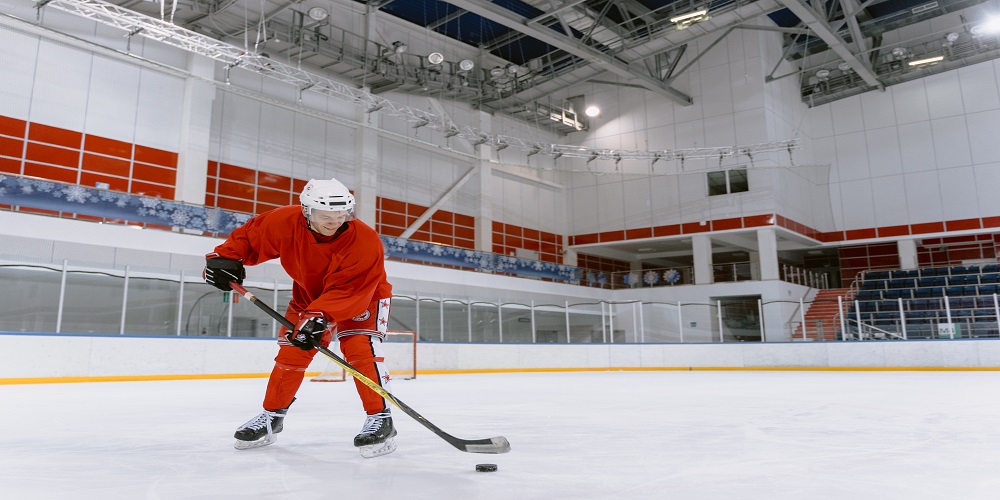Hockey is a fast-paced and physically demanding sport that requires players to be in top physical condition. Despite the rigorous training and conditioning that players undergo, injuries are still common in the sport.
This blog post will look at the 7 most common hockey injuries and how to prevent them.

Head Injuries can occur in hockey play
Head injuries are one of the most severe injuries that can occur in hockey and have long-term consequences for players. The most common head injuries in hockey include concussions, skull fractures, and brain contusions.
If you get a head injury while playing hockey, make sure to seek chiropractic care for hockey injuries.
Preventing head injuries
You should always wear a properly fitted helmet designed for hockey to prevent head injuries.
You should also ensure that the helmet is adjusted correctly and that the straps are tightened to ensure a secure fit.
Another way to prevent head injuries is to avoid dangerous plays, such as checking from behind or hitting players.
Shoulder Injuries are also common in hockey
Shoulder injuries can include mild sprains or more severe dislocations and fractures. The most common shoulder injuries in hockey include rotator cuff tears, labral tears and AC joint sprains.
Preventing shoulder injuries
To prevent shoulder injuries, you should focus on strengthening their shoulders and upper body. It can be done through exercises such as push-ups, pull-ups, and rows.
Remember to make sure you are using the proper technique while hitting or checking, as this can help to reduce the risk of shoulder injuries.
You should also wear protective gear, such as shoulder pads, and avoid dangerous plays.
Hand and Wrist Injuries during hockey play
Hand and wrist injuries can range from mild sprains to more severe fractures and dislocations. The most common hand and wrist injuries in hockey include wrist sprains, hand fractures and finger dislocations.
Preventing hand and wrist injuries
Try to strengthen your hands and wrists to prevent hand and wrist injuries. It can be done through grip strength exercises and wrist flexion exercises.
In addition, use a proper technique while handling the puck, as this can help to reduce the risk of hand and wrist injuries.
Wear protective clothing, such as gloves and wrist guards.
Knee Injuries in hockey play
Knee injuries mainly involve severe ligament tears and cartilage damage. The most common knee injuries in hockey include ACL tears, MCL tears and Meniscal tears.
Preventing knee injuries
To prevent knee injuries, work hard on your legs and core. For example, you can do squats, lunges, and leg presses.
Wear high-quality knee pads to protect yourself during the play.
Groin Injuries in a hockey play
Groin injuries can be a very unsettling problem for hockey players. They can be caused by overuse, improper stretching, or poor technique.
Preventing groin Injuries
To prevent groin injuries, stretching properly before and after games and practices is essential.
Additionally, it’s essential to practice good form when skating and shooting to reduce the strain on the groin.
Face injuries are also common in hockey
As a hockey player, you know that the sport can be incredibly intense and fast-paced. Unfortunately, this also means you risk getting hit in the face with a puck or stick.
Preventing face injuries
To prevent these types of injuries, it’s essential to wear the proper protective gear, including a full cage or visor on your helmet.
Additionally, always keep your head up and be aware of your surroundings on the ice.
Broken Bones can be a serious side effect of not being careful in a hockey play
Another common injury in hockey is broken bones. Whether from getting hit by a puck or a body check, broken bones can happen at any time.
Preventing broken bones
To prevent broken bones, it’s essential to wear the proper protective gear, such as padding for your chest, arms, and legs.
Stretching and regular strength training exercises are also essential to maintain good physical health.
Hockey is a physically demanding sport that can result in various injuries. These include head injuries and shoulder injuries. You can also get hand injuries and groin injuries. Facial injuries and broken bones are also possible.
By understanding the most common injuries, you can take steps to prevent them.
Remember to wear protective gear. Stretch properly before games and practices. Also, maintaining good conditioning can help you avoid getting hurt during play. Remember to always listen to your body and rest when needed. If an injury occurs, seek medical attention immediately.

